The three phase string inverter market is estimated to be valued at USD 18.5 billion in 2025 and is projected to reach USD 50.1 billion by 2035, registering a compound annual growth rate (CAGR) of 10.5% over the forecast period.
The three phase string inverter market is expected to grow from USD 18.5 billion in 2025 to USD 50.1 billion by 2035, registering a 10.5% CAGR and generating an absolute dollar opportunity of USD 31.6 billion. Growth is driven by increasing adoption of solar PV systems in commercial, industrial, and utility-scale applications, where three phase string inverters provide higher efficiency, enhanced reliability, and better grid integration compared with conventional inverters.
Expansion is supported by rising renewable energy mandates, declining solar module costs, and technological advancements such as smart monitoring, enhanced power conversion efficiency, and modular inverter designs. The growth contribution index indicates that the majority of market expansion in the early phase from 2025 to 2028 is volume-driven, as solar installations accelerate in North America, Europe, and Asia Pacific. During this period, rising system deployment and large-scale solar projects contribute the largest share of absolute dollar growth. Between 2029 and 2032, the contribution from price growth increases, as advanced inverter solutions with improved efficiency, enhanced durability, and integrated energy management systems command premium pricing.
From 2033 to 2035, the market exhibits a balanced mix of volume and price contribution, with revenue increasingly derived from upgrades, retrofits, and specialized applications in emerging regions. Overall, the USD 31.6 billion opportunity reflects a combination of expanding deployment volumes and value-added pricing, highlighting sustained and diversified growth for the three phase string inverter market between 2025 and 2035.
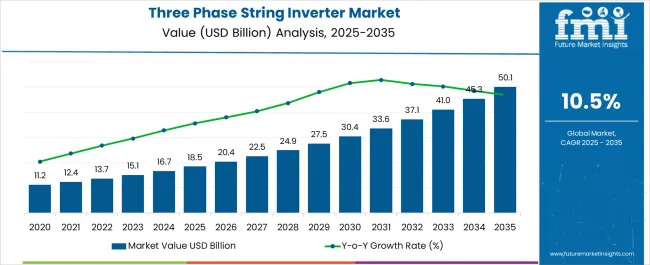
| Metric | Value |
|---|---|
| Three Phase String Inverter Market Estimated Value in (2025 E) | USD 18.5 billion |
| Three Phase String Inverter Market Forecast Value in (2035 F) | USD 50.1 billion |
| Forecast CAGR (2025 to 2035) | 10.5% |
The three phase string inverter market is driven by five primary parent markets with specific shares. Solar photovoltaic (PV) systems lead with 45%, as three phase string inverters efficiently convert DC power to AC for residential, commercial, and utility-scale installations. Commercial and industrial solar installations contribute 25%, supporting medium- and large-scale energy generation with optimized performance. Residential solar accounts for 15%, integrating inverters for rooftop systems and microgrids. Energy storage solutions represent 10%, combining inverters with batteries for grid stabilization and backup. Electric vehicle charging infrastructure holds 5%, leveraging inverters for renewable-powered fast charging. These sectors collectively define global demand.
Recent developments in the three phase string inverter market focus on efficiency, smart integration, and renewable energy optimization. Manufacturers are improving conversion efficiency, thermal management, and reliability while reducing size and weight. Advanced monitoring systems, IoT connectivity, and remote diagnostics are enabling real-time performance tracking and predictive maintenance. Hybrid inverters supporting both solar and battery storage are gaining traction to enhance energy management. Expansion of commercial and industrial solar projects, government incentives, and increased renewable adoption are driving market growth. These trends are shaping innovation, improving energy efficiency, and promoting widespread deployment of three phase string inverters.
The three phase string inverter market is advancing steadily, supported by the global expansion of renewable energy infrastructure and the increasing integration of solar PV systems in residential, commercial, and industrial sectors. These inverters offer a balanced combination of efficiency, cost-effectiveness, and scalability, making them suitable for a wide range of photovoltaic installations.
Current demand is driven by government incentives, declining solar component costs, and improved grid stability features incorporated in modern inverter designs. Technological advancements, such as enhanced MPPT capabilities and remote monitoring, have strengthened operational reliability, encouraging adoption in both new projects and retrofits.
The market outlook remains positive as distributed generation gains traction and grid modernization initiatives accelerate. With the push toward sustainable energy targets and increasing acceptance of decentralized power solutions, three phase string inverters are expected to maintain their strategic importance across diverse applications.
The three phase string inverter market is segmented by connectivity, application, and geographic regions. By connectivity, three phase string inverter market is divided into standalone and on grid. In terms of application, three phase string inverter market is classified into residential, commercial & industrial, and utility. Regionally, the three phase string inverter industry is classified into North America, Latin America, Western Europe, Eastern Europe, Balkan & Baltic Countries, Russia & Belarus, Central Asia, East Asia, South Asia & Pacific, and the Middle East & Africa.
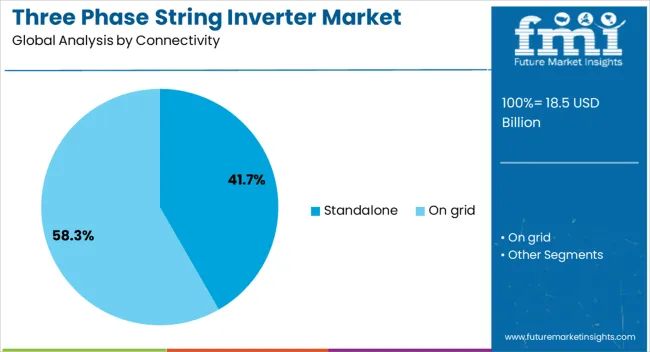
The on grid segment leads the connectivity category, holding approximately 58.3% share of the three phase string inverter market. This leadership is attributed to the segment’s ability to seamlessly integrate with existing utility networks, making it ideal for urban, industrial, and large-scale commercial installations.
Its adoption has been bolstered by the expansion of solar PV projects under net metering policies, feed-in tariffs, and government-backed renewable integration programs. On-grid inverters are also favored for their role in reducing electricity costs by feeding excess solar power back into the grid, enhancing overall system efficiency.
Advances in smart inverter technologies, grid support functionalities, and real-time monitoring systems have improved the reliability and value proposition of these solutions, further strengthening market uptake. With ongoing investments in grid-connected solar farms, distributed generation, and smart city infrastructure, the on-grid segment is anticipated to maintain a dominant position in the coming years.
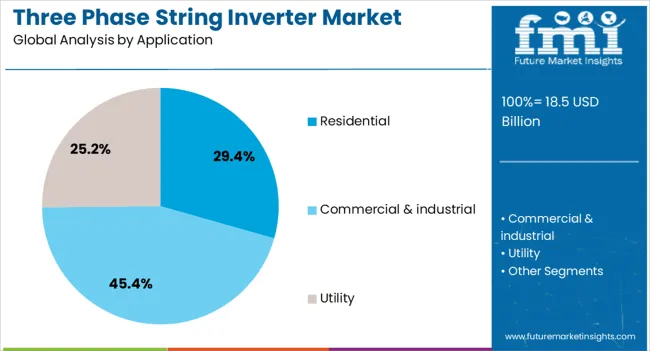
The commercial & industrial segment dominates the application category with approximately 45.4% share, driven by the rising adoption of solar PV systems among businesses and manufacturing facilities seeking to reduce operational costs and improve energy sustainability. Supportive policies, corporate decarbonization goals, and attractive return-on-investment models have accelerated adoption in this segment.
Commercial and industrial users benefit from the scalability, high power output, and robust performance of three phase string inverters, making them suitable for large rooftop arrays, ground-mounted systems, and industrial energy management applications. Integration with smart grid solutions, demand response programs, and hybrid storage systems has further strengthened market uptake.
With growing emphasis on ESG targets, energy security, and long-term cost savings, the commercial & industrial segment is expected to maintain strong growth momentum and remain a primary demand driver for the three phase string inverter market globally.
The global three phase string inverter market is expanding due to rising demand for efficient solar energy systems in commercial, industrial, and utility-scale projects. Asia Pacific accounted for 45% of adoption in 2024, driven by China, India, and Japan, while Europe focuses on rooftop and large-scale installations in Germany, Spain, and Italy. North America emphasizes high-capacity inverters for commercial solar projects. Advancements in power conversion efficiency, monitoring systems, and grid compliance standards are enhancing adoption. Increasing renewable energy targets, declining solar module costs, and government incentives are driving measurable growth globally.
The primary driver of the three phase string inverter market is the need for high-efficiency conversion in solar PV installations. Modern string inverters achieve 98–99% efficiency, optimizing energy yield for commercial and utility-scale systems. Asia Pacific leads adoption due to large rooftop and industrial solar projects, while Europe emphasizes smart grid and net-zero integration. String inverters offer cost advantages over central inverters for installations under 500 kW, with lower balance-of-system expenses and simplified maintenance. Rising government incentives, renewable energy mandates, and demand for energy management integration in industrial and commercial facilities further propel market growth, making three phase string inverters a preferred choice globally.
Opportunities arise from grid modernization, energy storage integration, and smart PV system expansion. Three phase string inverters increasingly incorporate monitoring software, IoT connectivity, and remote diagnostics, enabling predictive maintenance and real-time energy optimization. Asia Pacific’s industrial rooftop solar segment is growing at 12–15% annually, while Europe and North America deploy string inverters for hybrid solar-plus-storage projects. Emerging markets in Latin America and Middle East & Africa present expansion potential due to rising industrialization and off-grid solar adoption. Manufacturers offering modular, multi-MPPT, and high-voltage string inverters can capture significant opportunities in distributed and commercial solar applications globally.
Key trends include advanced multi-MPPT tracking, IoT-enabled monitoring, and modular inverter architectures. Multi-MPPT allows each solar string to operate at peak power despite shading or mismatch, improving energy yield by 5–10%. Digital monitoring platforms provide real-time alerts, predictive maintenance, and data analytics for energy efficiency. Europe leads in adoption of smart PV monitoring standards, while Asia Pacific emphasizes high-voltage and modular designs for large commercial rooftops. Lightweight, compact enclosures and fanless cooling systems are increasingly deployed. Hybrid-ready string inverters, compatible with battery storage and EV charging, are gaining traction, reflecting a trend toward integrated, high-performance solar solutions worldwide.
Despite advantages, the three phase string inverter market faces constraints from high upfront costs, technical complexity, and environmental factors. Large-scale installations over 1 MW may require multiple units, increasing system cost compared with central inverters. Thermal management and environmental protection are essential in hot and humid climates to maintain efficiency and lifespan. Skilled personnel are required for installation, monitoring, and troubleshooting, increasing labor costs. Regulatory compliance with grid codes, anti-islanding protection, and EMC standards adds complexity. Manufacturers must provide training, robust designs, and modular solutions to overcome these challenges and ensure reliable adoption in commercial, industrial, and utility solar PV systems globally.
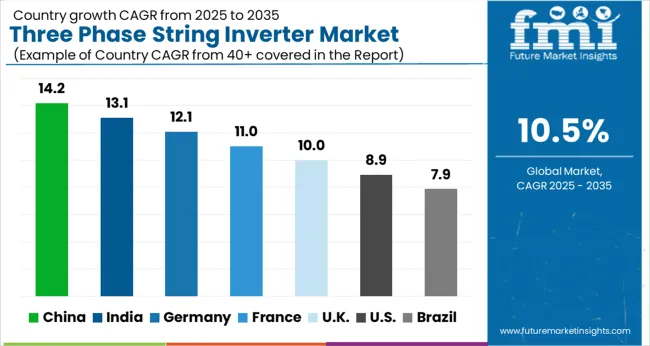
| Country | CAGR |
|---|---|
| China | 14.2% |
| India | 13.1% |
| Germany | 12.1% |
| France | 11.0% |
| UK | 10.0% |
| USA | 8.9% |
| Brazil | 7.9% |
The three phase string inverter market is projected to grow at a global CAGR of 10.5% through 2035, fueled by increasing adoption of renewable energy systems, grid modernization, and industrial solar installations. China leads at 14.2%, a 1.35× multiple of the global benchmark, driven by BRICS-backed solar infrastructure, large-scale photovoltaic projects, and domestic manufacturing capacity. India follows at 13.1%, a 1.25× multiple, reflecting strong demand for solar installations, government renewable energy initiatives, and industrial uptake. Germany records 12.1%, a 1.15× multiple, shaped by OECD-supported energy efficiency policies and commercial solar adoption. The United Kingdom posts 10.0%, close to the global rate, with adoption focused on commercial and industrial PV systems. The United States stands at 8.9%, 0.85× the benchmark, supported by steady industrial solar projects and distributed energy systems. BRICS countries drive volume growth, OECD regions focus on technological advancement and compliance, while ASEAN markets contribute through expanding solar infrastructure. This report includes insights on 40+ countries; the top markets are shown here for reference.
The three phase string inverter market in China is projected to expand at a CAGR of 14.2%, driven by accelerated adoption of large-scale and commercial solar photovoltaic installations. Key manufacturers including Sungrow, Huawei, and GoodWe are supplying high-efficiency, reliable string inverters with advanced monitoring and grid integration features. Adoption is concentrated in industrial parks, commercial rooftops, and utility-scale solar farms. Government policies promoting renewable energy deployment and grid stability reinforce market growth. Technological trends include smart monitoring, remote diagnostics, and integration with energy storage systems to optimize performance and reduce downtime. Investments in hybrid solar-plus-storage solutions further strengthen market adoption.
The three phase string inverter market in India is expected to grow at a CAGR of 13.1%, supported by government renewable energy targets, rooftop solar programs, and expanding industrial solar adoption. Manufacturers such as ABB, Sungrow, and TMEIC are supplying high-performance string inverters for commercial, industrial, and large-scale solar projects. Adoption is concentrated in urban and industrial hubs, with increasing deployment in utility-scale solar farms. Initiatives to improve grid reliability and integrate energy storage are encouraging adoption. Investments in smart inverter technology and remote monitoring systems enhance performance and reduce maintenance costs, driving market expansion.
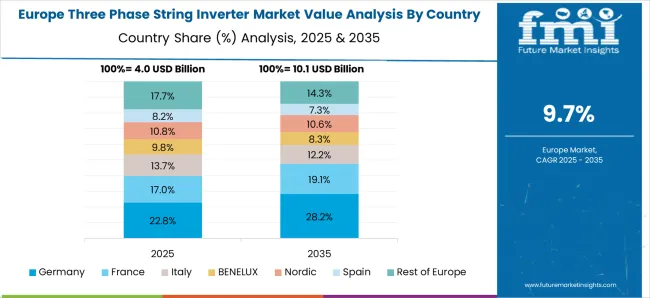
The three phase string inverter market in Germany is projected to grow at a CAGR of 12.1%, supported by strong renewable energy policies, grid stability requirements, and industrial solar adoption. Suppliers including SMA Solar Technology, Fronius, and ABB are providing string inverters optimized for efficiency, grid compliance, and energy storage integration. Adoption is concentrated in industrial facilities, commercial rooftops, and utility-scale PV installations. Technological advancements in inverter monitoring, predictive maintenance, and hybrid storage solutions support market growth. Renewable energy incentives and electricity market reforms reinforce deployment of high-performance string inverters.
The three phase string inverter market in the United Kingdom is forecast to expand at a CAGR of 10.0%, driven by commercial, industrial, and large-scale solar adoption. Manufacturers including SMA, Huawei, and Fronius are supplying efficient inverters with smart monitoring and grid management features. Adoption is focused on urban centers, commercial facilities, and utility-scale solar farms. Government incentives, net-zero carbon policies, and renewable energy targets encourage deployment. Integration with energy storage systems and hybrid PV solutions is further strengthening market growth. Increasing demand for digital monitoring and predictive maintenance solutions ensures reliability and performance for large-scale solar installations.
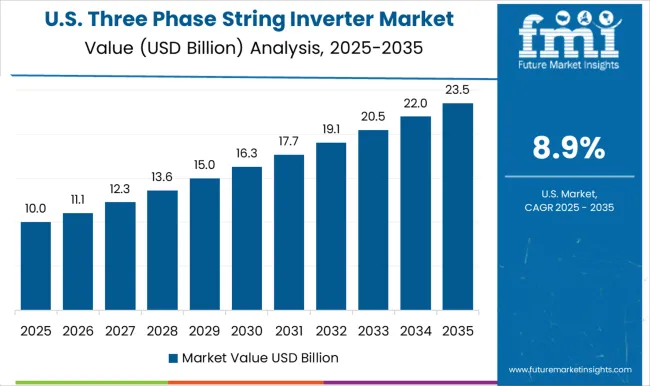
The three phase string inverter market in the United States is projected to grow at a CAGR of 8.9%, supported by commercial, industrial, and utility-scale solar projects. Key players such as ABB, SMA, and SolarEdge are supplying high-efficiency inverters with remote monitoring and grid support capabilities. Adoption is concentrated in solar-rich states and urban industrial hubs. Investments in energy storage integration, hybrid PV solutions, and smart grid compatibility enhance deployment. Government incentives, renewable energy policies, and corporate sustainability programs are driving adoption in commercial and industrial segments.
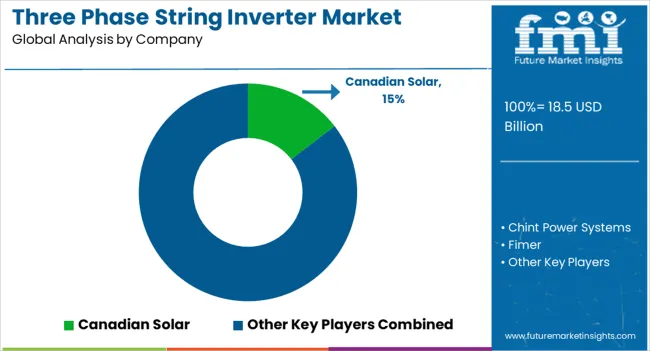
Competition in the three phase string inverter market is driven by global solar technology providers and specialized inverter manufacturers, focusing on efficiency, reliability, and grid compatibility. Huawei Technologies, Sungrow, and Canadian Solar lead with high-performance inverters, emphasizing intelligent monitoring, durability, and seamless integration with commercial and industrial PV systems. Chint Power Systems and Fimer offer scalable solutions, targeting diverse solar installations with brochures highlighting technical specifications, efficiency ratings, and real-world performance. Goldi Solar, INVTSolar, and Solis Inverters focus on cost-effective and compact designs, catering to small to mid-sized projects. NingBo Deye Inverter Technology, UTL Solar, and Veichi Electric emphasize smart connectivity, remote monitoring, and operational reliability.
LEDVANCE integrates energy management features into inverter solutions, promoting optimized system performance. Product brochures highlight power conversion efficiency, warranty terms, environmental compliance, and safety certifications, providing essential information for system planners and installers. Marketing materials shape competitive positioning, combining technical data, visual schematics, and application guidance to support decision-making. Frequent brochure updates reflect evolving inverter technologies, regulatory compliance, and energy efficiency improvements.
Larger firms leverage global reach and brand recognition, while smaller companies focus on customization, innovation, and faster deployment. Market leadership is determined by how effectively brochures communicate efficiency, durability, and value in three phase string inverter solutions.
| Items | Values |
|---|---|
| Quantitative Units | USD 18.5 billion |
| Connectivity | Standalone and On grid |
| Application | Residential, Commercial & industrial, and Utility |
| Regions Covered | North America, Europe, Asia-Pacific, Latin America, Middle East & Africa |
| Country Covered | United States, Canada, Germany, France, United Kingdom, China, Japan, India, Brazil, South Africa |
| Key Companies Profiled | Canadian Solar, Chint Power Systems, Fimer, Goldi Solar, Huawei Technologies, INVTSolar, LEDVANCE, NingBo Deye Inverter Technology, SUNGROW, Solis Inverters, UTL Solar, and Veichi Electric |
| Additional Attributes | Dollar sales by inverter type and use rise with solar, storage, smart grids; innovation drives efficiency, reliability, grid compatibility; environmental concerns persist; Asia-Pacific leads demand, with growing adoption in North America, Europe |
The global three phase string inverter market is estimated to be valued at USD 18.5 billion in 2025.
The market size for the three phase string inverter market is projected to reach USD 50.1 billion by 2035.
The three phase string inverter market is expected to grow at a 10.5% CAGR between 2025 and 2035.
The key product types in three phase string inverter market are standalone and on grid.
In terms of application, commercial & industrial segment to command 45.4% share in the three phase string inverter market in 2025.






Our Research Products

The "Full Research Suite" delivers actionable market intel, deep dives on markets or technologies, so clients act faster, cut risk, and unlock growth.

The Leaderboard benchmarks and ranks top vendors, classifying them as Established Leaders, Leading Challengers, or Disruptors & Challengers.

Locates where complements amplify value and substitutes erode it, forecasting net impact by horizon

We deliver granular, decision-grade intel: market sizing, 5-year forecasts, pricing, adoption, usage, revenue, and operational KPIs—plus competitor tracking, regulation, and value chains—across 60 countries broadly.

Spot the shifts before they hit your P&L. We track inflection points, adoption curves, pricing moves, and ecosystem plays to show where demand is heading, why it is changing, and what to do next across high-growth markets and disruptive tech

Real-time reads of user behavior. We track shifting priorities, perceptions of today’s and next-gen services, and provider experience, then pace how fast tech moves from trial to adoption, blending buyer, consumer, and channel inputs with social signals (#WhySwitch, #UX).

Partner with our analyst team to build a custom report designed around your business priorities. From analysing market trends to assessing competitors or crafting bespoke datasets, we tailor insights to your needs.
Supplier Intelligence
Discovery & Profiling
Capacity & Footprint
Performance & Risk
Compliance & Governance
Commercial Readiness
Who Supplies Whom
Scorecards & Shortlists
Playbooks & Docs
Category Intelligence
Definition & Scope
Demand & Use Cases
Cost Drivers
Market Structure
Supply Chain Map
Trade & Policy
Operating Norms
Deliverables
Buyer Intelligence
Account Basics
Spend & Scope
Procurement Model
Vendor Requirements
Terms & Policies
Entry Strategy
Pain Points & Triggers
Outputs
Pricing Analysis
Benchmarks
Trends
Should-Cost
Indexation
Landed Cost
Commercial Terms
Deliverables
Brand Analysis
Positioning & Value Prop
Share & Presence
Customer Evidence
Go-to-Market
Digital & Reputation
Compliance & Trust
KPIs & Gaps
Outputs
Full Research Suite comprises of:
Market outlook & trends analysis
Interviews & case studies
Strategic recommendations
Vendor profiles & capabilities analysis
5-year forecasts
8 regions and 60+ country-level data splits
Market segment data splits
12 months of continuous data updates
DELIVERED AS:
PDF EXCEL ONLINE
Three Wheeled Motorcycle Market Size and Share Forecast Outlook 2025 to 2035
Three-Wheel E-Scooter Market Growth - Trends & Forecast 2024 to 2034
Three Piece Cans Market
Three Phase Commercial Voltage Regulator Market Size and Share Forecast Outlook 2025 to 2035
Three Phase Residential Voltage Regulator Market Size and Share Forecast Outlook 2025 to 2035
Three Phase Recloser Market Size and Share Forecast Outlook 2025 to 2035
Three Phase Green Power Transformer Market Size and Share Forecast Outlook 2025 to 2035
Three Phase Residential Power Conditioner Market Size and Share Forecast Outlook 2025 to 2035
Three Phase Shunt Reactor Market Size and Share Forecast Outlook 2025 to 2035
Three Phase Power Device Analyzer Market Size and Share Forecast Outlook 2025 to 2035
Three Phase Inverter Market Size and Share Forecast Outlook 2025 to 2035
Three Phase Micro Inverter Market Size and Share Forecast Outlook 2025 to 2035
On-grid Three Phase PV Inverter Market Size and Share Forecast Outlook 2025 to 2035
Electric Three Wheeler Market - Trends & Forecast 2025 to 2035
Automotive Three Way Catalytic Converter Market Size and Share Forecast Outlook 2025 to 2035
Air Cooled Three Phase Home Standby Gensets Market Size and Share Forecast Outlook 2025 to 2035
Standalone Three Phase PV Inverter Market Size and Share Forecast Outlook 2025 to 2035
Commercial Three Phase Micro Inverter Market Size and Share Forecast Outlook 2025 to 2035
Phase Shifting Transformer Market Size and Share Forecast Outlook 2025 to 2035
Dual-Phase Cleanser Market Size and Share Forecast Outlook 2025 to 2035

Thank you!
You will receive an email from our Business Development Manager. Please be sure to check your SPAM/JUNK folder too.
Chat With
MaRIA